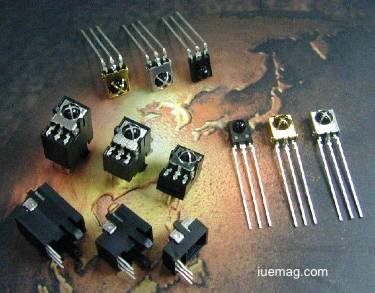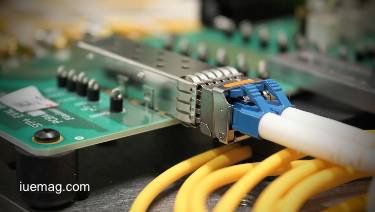

Development Status of Silicon-Based Optoelectronics in Optical Communication
 Silicon-based optoelectronic technology has the advantages of broadband, high speed, and anti-interference characteristics of light, as well as the advantages of large-scale integration, low energy consumption, and low cost of microelectronic technology. In the past ten years, silicon-based optoelectronics technology has entered the field of the communication industry and has given full play to its advantages in high-speed and short-distance application scenarios above 800 Gbit/s, posing a challenge to a traditional indium phosphide (InP) communication optical modules.
Silicon-based optoelectronic technology has the advantages of broadband, high speed, and anti-interference characteristics of light, as well as the advantages of large-scale integration, low energy consumption, and low cost of microelectronic technology. In the past ten years, silicon-based optoelectronics technology has entered the field of the communication industry and has given full play to its advantages in high-speed and short-distance application scenarios above 800 Gbit/s, posing a challenge to a traditional indium phosphide (InP) communication optical modules.Briefly discuss the application and development of silicon-based optoelectronic technology in communication, and briefly introduce some challenges in the application of silicon-based optoelectronic technology. Only by solving the deficiencies in device performance, packaging technology, and automation software can the rapid development of silicon-based optoelectronics technology be realized.
Microelectronics technology dominated by silicon materials has achieved world-renowned achievements in the past half a century, and has always been the driving force for the development of modern information society. The development of microelectronic chips follows Moore's Law, but as the process nodes of microelectronic chips approach the atomic level, the impact of quantum effects on chip performance intensifies, and Moore's Law is facing failure. People use multi-core processors to increase performance and reduce power consumption, but the signal transmission speed of the bus restricts the processing capacity of the processor.
Due to electromagnetic interference and time delay, traditional electrical interconnection cannot meet the needs of future high-speed data communication. Optical communication has the characteristics of anti-electromagnetic interference, high transmission rate, low energy consumption, and low delay. As a medium for information interconnection, light has inherent advantages over electrical signals. In the 1970s, Miller of Bell Laboratories in the United States proposed the concept of integrated optics, with the goal of integrating optical devices and electrical devices in the same chip.
 With the development of the early Internet, semiconductor materials of Group III and V compounds became the first choice for optical communication and promoted the development of optical communication. The main material of integrated optical communication chips during this period is indium phosphide (InP). InP is a direct bandgap semiconductor with high carrier mobility, which can directly prepare key optoelectronic devices such as high-speed semiconductor lasers, amplifiers, and modulators.
With the development of the early Internet, semiconductor materials of Group III and V compounds became the first choice for optical communication and promoted the development of optical communication. The main material of integrated optical communication chips during this period is indium phosphide (InP). InP is a direct bandgap semiconductor with high carrier mobility, which can directly prepare key optoelectronic devices such as high-speed semiconductor lasers, amplifiers, and modulators.
Microelectronics technology dominated by silicon materials has achieved world-renowned achievements in the past half a century, and has always been the driving force for the development of modern information society. The development of microelectronic chips follows Moore's Law, but as the process nodes of microelectronic chips approach the atomic level, the impact of quantum effects on chip performance intensifies, and Moore's Law is facing failure. People use multi-core processors to increase performance and reduce power consumption, but the signal transmission speed of the bus restricts the processing capacity of the processor.
Due to electromagnetic interference and time delay, traditional electrical interconnection cannot meet the needs of future high-speed data communication. Optical communication has the characteristics of anti-electromagnetic interference, high transmission rate, low energy consumption, and low delay. As a medium for information interconnection, light has inherent advantages over electrical signals. In the 1970s, Miller of Bell Laboratories in the United States proposed the concept of integrated optics, with the goal of integrating optical devices and electrical devices in the same chip.
 With the development of the early Internet, semiconductor materials of Group III and V compounds became the first choice for optical communication and promoted the development of optical communication. The main material of integrated optical communication chips during this period is indium phosphide (InP). InP is a direct bandgap semiconductor with high carrier mobility, which can directly prepare key optoelectronic devices such as high-speed semiconductor lasers, amplifiers, and modulators.
With the development of the early Internet, semiconductor materials of Group III and V compounds became the first choice for optical communication and promoted the development of optical communication. The main material of integrated optical communication chips during this period is indium phosphide (InP). InP is a direct bandgap semiconductor with high carrier mobility, which can directly prepare key optoelectronic devices such as high-speed semiconductor lasers, amplifiers, and modulators.However, indium is a rare material and expensive; InP wafers are small in size, low in yield, and rely on complex epitaxy processes. This has raised the cost of optical communication chips based on InP materials. The cost of the current InP optical module is about 1 USD / (Gbit/s−1), and it is difficult to further reduce it.
With the further development and upgrading of telecommunications and the Internet, the application requirements of 5G, the Internet of Things, and data centers have increased the channel capacity of optical communication systems by 5 orders of magnitude in the past 30 years. The upgrade of optical communication system technology routes depends on technological innovation.
Optical communication systems and modulation formats are becoming increasingly complex. In the current mainstream backbone network and data center communication systems, 100G optical modules and chips based on coherent communication technology and wavelength division multiplexing technology are widely used. In the future, optical communication chips and modules will evolve to 400 Gbit/s, 800 Gbit/s, or even Tbit/s (level speed and there is an urgent need to develop more integrated and lower-cost optical communication chips and modules.
In addition to long-distance data transmission, silicon-based optoelectronics can also meet short-distance and large-capacity data transmission within/between microelectronic chips. Through monolithic integration with microelectronic integrated circuits, high-speed, low-power on-chip interconnection is achieved, breaking through the bottleneck of current microelectronic processors in data interconnection.
Image Credits:Image 1: A.dobratiqi, CC BY-SA 3.0, via Wikimedia Commons | Image 2: Optical module
With the further development and upgrading of telecommunications and the Internet, the application requirements of 5G, the Internet of Things, and data centers have increased the channel capacity of optical communication systems by 5 orders of magnitude in the past 30 years. The upgrade of optical communication system technology routes depends on technological innovation.
Optical communication systems and modulation formats are becoming increasingly complex. In the current mainstream backbone network and data center communication systems, 100G optical modules and chips based on coherent communication technology and wavelength division multiplexing technology are widely used. In the future, optical communication chips and modules will evolve to 400 Gbit/s, 800 Gbit/s, or even Tbit/s (level speed and there is an urgent need to develop more integrated and lower-cost optical communication chips and modules.
In addition to long-distance data transmission, silicon-based optoelectronics can also meet short-distance and large-capacity data transmission within/between microelectronic chips. Through monolithic integration with microelectronic integrated circuits, high-speed, low-power on-chip interconnection is achieved, breaking through the bottleneck of current microelectronic processors in data interconnection.
Image Credits:Image 1: A.dobratiqi, CC BY-SA 3.0, via Wikimedia Commons | Image 2: Optical module
Copyrights © 2026 Inspiration Unlimited - iU - Online Global Positivity Media
Any facts, figures or references stated here are made by the author & don't reflect the endorsement of iU at all times unless otherwise drafted by official staff at iU. A part [small/large] could be AI generated content at times and it's inevitable today. If you have a feedback particularly with regards to that, feel free to let us know. This article was first published here on 28th December 2022.
Overthinking? Uninspired? Brain Fogged?
Let's Reset That! Try iU's Positivity Chat NOW!

All chats are end-to-end encrypted by WhatsApp and won't be shared anywhere [won't be stored either].


